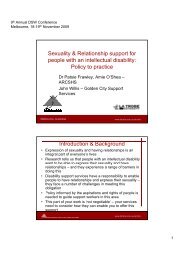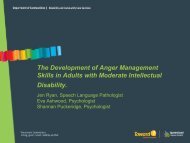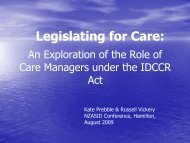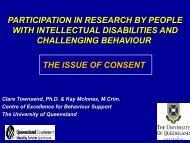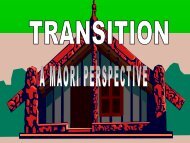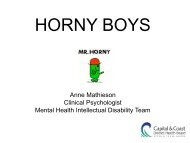1 D l t ld l A Developmental delay: An ambiguous term in need of ...
1 D l t ld l A Developmental delay: An ambiguous term in need of ...
1 D l t ld l A Developmental delay: An ambiguous term in need of ...
Create successful ePaper yourself
Turn your PDF publications into a flip-book with our unique Google optimized e-Paper software.
ASSID Conference - Melbourne 24-26 th November 2008<br />
Background<br />
Ms Lisa Grech, B.Bus, B.Arts (Hons)<br />
School <strong>of</strong> Psychology, Psychiatry & Psychological Medic<strong>in</strong>e<br />
<strong>Developmental</strong> l <strong>delay</strong>: <strong>An</strong><br />
<strong>ambiguous</strong> <strong>term</strong> <strong>in</strong> <strong>need</strong> <strong>of</strong><br />
change.<br />
• Mother to a six-year-o<strong>ld</strong> chi<strong>ld</strong> with a severe<br />
<strong>in</strong>tellectual disability, who was provided the<br />
<strong>in</strong>terim diagnostic label “Global<br />
<strong>Developmental</strong> Delay” for her first five years.<br />
• In contact with many parents, <strong>in</strong>tervention<br />
therapists and medical specialists that<br />
provided anecdotal evidence that this <strong>term</strong> is<br />
thought <strong>of</strong> as <strong>ambiguous</strong> and mislead<strong>in</strong>g.<br />
www.med.monash.edu.au<br />
www.med.monash.edu.au<br />
2<br />
Why do we <strong>need</strong> a change?<br />
• The <strong>term</strong> is <strong>ambiguous</strong> and mislead<strong>in</strong>g:<br />
– Difficult for medical pr<strong>of</strong>essionals try<strong>in</strong>g to<br />
provide a true picture <strong>of</strong> the situation<br />
– Difficult for parents/carers try<strong>in</strong>g to understand<br />
the situation<br />
• Is <strong>in</strong>consistent with research about best<br />
practice <strong>in</strong> convey<strong>in</strong>g diagnosis<br />
• May <strong>in</strong>terfere with the griev<strong>in</strong>g process<br />
• Does not allow for acceptance <strong>of</strong> the chi<strong>ld</strong><br />
as the person they are<br />
www.med.monash.edu.au<br />
3<br />
What is ‘<strong>Developmental</strong> Delay’?<br />
• In Victoria, accord<strong>in</strong>g to the Disability Act, 2006:<br />
– <strong>Developmental</strong> <strong>delay</strong> means a <strong>delay</strong> <strong>in</strong> development<br />
<strong>of</strong> a chi<strong>ld</strong> under the age <strong>of</strong> six years which-<br />
> is attributed to a mental or physical impairment or a<br />
comb<strong>in</strong>ation o <strong>of</strong> both; and<br />
> is manifested before the age <strong>of</strong> six years; and<br />
> Results <strong>in</strong> substantial functional limitation <strong>in</strong> one or<br />
more <strong>of</strong> self-care, receptive and expressive language,<br />
cognitive development and motor function; and<br />
> Reflects the chi<strong>ld</strong>’s <strong>need</strong> for special care, treatment or<br />
other services <strong>of</strong> extended duration.<br />
www.med.monash.edu.au<br />
4<br />
No standardised diagnostic criteria<br />
• DHS checklist to de<strong>term</strong><strong>in</strong>e service eligibility<br />
• Chi<strong>ld</strong> has not met their expected milestones,<br />
eg. upper limit for be<strong>in</strong>g able to sit is 10<br />
months, thus chi<strong>ld</strong> is considered <strong>delay</strong>ed if<br />
not sitt<strong>in</strong>g >11 months<br />
• If a chi<strong>ld</strong> is <strong>delay</strong>ed by 25% and/or 2 SD from<br />
the mean <strong>in</strong> one or more development<br />
doma<strong>in</strong>s (Tervo, 2003)<br />
• Researchers have used parameters <strong>of</strong> 1.5 SD<br />
from the mean (Shevell et al, 2005a & 2005b)<br />
www.med.monash.edu.au<br />
5<br />
Multiple applications <strong>of</strong> the <strong>term</strong><br />
• As a euphemism for <strong>in</strong>tellectual disability or as<br />
a way <strong>of</strong> avoid<strong>in</strong>g the <strong>term</strong> <strong>in</strong>tellectual disability<br />
• Because a chi<strong>ld</strong> scored low on a test <strong>of</strong><br />
development and/or IQ<br />
• To describe a <strong>delay</strong> <strong>in</strong> premature babies<br />
• As a reference to any chi<strong>ld</strong> with dev. problems<br />
• As an <strong>in</strong>terim diagnostic label<br />
• As a symptom <strong>of</strong> a larger neurodevelopmental<br />
diagnosis<br />
(Petersen, Tube & Palmer, 1998)<br />
www.med.monash.edu.au<br />
6<br />
1
ASSID Conference - Melbourne 24-26 th November 2008<br />
Ambiguity <strong>of</strong> the label<br />
• The word ‘<strong>delay</strong>’ is identified with a temporary<br />
state that will end <strong>in</strong> goal atta<strong>in</strong>ment.<br />
• “rather like a tra<strong>in</strong> be<strong>in</strong>g <strong>delay</strong>ed, but reach<strong>in</strong>g<br />
its dest<strong>in</strong>ation eventually” (Bosley, 2005, p. 875).<br />
• The Oxford English Dictionary (1989) def<strong>in</strong>es<br />
<strong>delay</strong> as:<br />
– The action <strong>of</strong> <strong>delay</strong><strong>in</strong>g: the putt<strong>in</strong>g <strong>of</strong>f or deferr<strong>in</strong>g<br />
action; procrast<strong>in</strong>ation, loiter<strong>in</strong>g; wait<strong>in</strong>g, l<strong>in</strong>ger<strong>in</strong>g;<br />
– The fact <strong>of</strong> be<strong>in</strong>g <strong>delay</strong>ed or kept wait<strong>in</strong>g for a time;<br />
h<strong>in</strong>drance to progress<br />
www.med.monash.edu.au<br />
7<br />
<strong>Developmental</strong> <strong>delay</strong> outcomes<br />
• Transient developmental <strong>delay</strong><br />
– Is the type <strong>of</strong> <strong>delay</strong> <strong>of</strong>ten seen <strong>in</strong> pre<strong>term</strong> babies or<br />
chi<strong>ld</strong>ren that have medical problems that are the<br />
cause <strong>of</strong> their slower development: These chi<strong>ld</strong>ren<br />
catch up<br />
• Persistent developmental <strong>delay</strong><br />
– Shevell et al. (2005a; 2005b) found that a<br />
preschool diagnosis <strong>of</strong> Global <strong>Developmental</strong><br />
Delay was predictive <strong>of</strong> persist<strong>in</strong>g developmental<br />
<strong>delay</strong> across <strong>in</strong>dividual doma<strong>in</strong>s <strong>of</strong> between 75%<br />
and 100% <strong>of</strong> chi<strong>ld</strong>ren<br />
www.med.monash.edu.au<br />
8<br />
Impart<strong>in</strong>g news about diagnosis<br />
• Factors that contribute to satisfaction with the<br />
process <strong>in</strong>clude:<br />
– Honesty about concerns and diagnosis provided as<br />
early as possible <strong>in</strong> a factual, compassionate manner<br />
– Accurate <strong>in</strong>formation about diagnosis and prognosis,<br />
available support, benefits and future educational<br />
opportunities<br />
– Immediate and ongo<strong>in</strong>g support so that parents feel<br />
that they are do<strong>in</strong>g someth<strong>in</strong>g to help their chi<strong>ld</strong><br />
– Hope and possibilities for the future, despite their<br />
chi<strong>ld</strong>’s disability (Piper & Howl<strong>in</strong>, 1992; Qu<strong>in</strong>e & Rutter, 1994)<br />
www.med.monash.edu.au<br />
9<br />
Impart<strong>in</strong>g news about diagnosis<br />
• Factors that contribute to dissatisfaction<br />
with the process <strong>in</strong>clude:<br />
– Withho<strong>ld</strong><strong>in</strong>g <strong>in</strong>formation<br />
– Ambiguous diagnosis and/or diagnostic labels<br />
– Lengthy process <strong>of</strong> diagnosis<br />
• A ‘wait and see’ approach is unhelpful<br />
because it means that parents have to<br />
source <strong>in</strong>formation and try to identify their<br />
chi<strong>ld</strong>’s problems themselves<br />
(Goodley & Tegaskis, 2006; Piper & Howl<strong>in</strong>, 1992)<br />
www.med.monash.edu.au<br />
10<br />
A new normal<br />
“I found that all really confus<strong>in</strong>g because I just<br />
loved him. When I was given the labels I knew<br />
that all my upbr<strong>in</strong>g<strong>in</strong>g to<strong>ld</strong> me that I wou<strong>ld</strong>n’t<br />
love a disabled chi<strong>ld</strong>. Yet I loved him, there<br />
was never any doubt. But it was def<strong>in</strong>itely a<br />
struggle to make sense <strong>of</strong> those mixed<br />
messages…he was so wrapped up <strong>in</strong> my love<br />
for him.”<br />
Quote from a mother recount<strong>in</strong>g a diagnosis<br />
<strong>of</strong> GDD (Goodley & Tregaskis, 2006)<br />
www.med.monash.edu.au<br />
11<br />
<strong>An</strong> argument for change<br />
• No standard diagnostic criteria<br />
• Multiple applications <strong>of</strong> the <strong>term</strong><br />
• Ambiguity <strong>of</strong> the label<br />
• Persistence <strong>of</strong> impairment<br />
• Parental dissatisfaction with <strong>ambiguous</strong><br />
diagnosis and/or diagnostic labels and<br />
withho<strong>ld</strong><strong>in</strong>g <strong>of</strong> <strong>in</strong>formation<br />
• Provision <strong>of</strong> realistic hope to enable parents to<br />
move through the grief process and f<strong>in</strong>d a ‘new<br />
normal’ for themselves and their family<br />
www.med.monash.edu.au<br />
12<br />
2
ASSID Conference - Melbourne 24-26 th November 2008<br />
Recommendations<br />
• Discussion and research <strong>in</strong>to the<br />
appropriateness or otherwise <strong>of</strong> developmental<br />
<strong>delay</strong> as an <strong>in</strong>terim <strong>term</strong><br />
• Development <strong>of</strong> standardised diagnostic<br />
markers and guidel<strong>in</strong>es<br />
• Development <strong>of</strong> a booklet for parents/carers that<br />
receive an <strong>in</strong>terim diagnosis with <strong>in</strong>formation<br />
about what it means and likely outcomes<br />
• Development <strong>of</strong> a strategy for adoption <strong>of</strong><br />
change<br />
www.med.monash.edu.au<br />
13<br />
A few key references<br />
Goodley, D., & Tregaskis, C. (2006). Story<strong>in</strong>g disability and impairment: Retrospective<br />
accounts <strong>of</strong> disabled family life. Qualitative Health Research, 16, 630-646.<br />
Petersen, M. C., Tube, D. A., & Palmer, F. B. (1998). Classification <strong>of</strong> developmental<br />
<strong>delay</strong>s. Sem<strong>in</strong>ars <strong>in</strong> Pedatric Neurology, 5, 2-14.<br />
Piper, E., & Howl<strong>in</strong>, P. (1992). Assess<strong>in</strong>g and diagnos<strong>in</strong>g developmental disorders that<br />
are not evident at birth: Parental evaluations <strong>of</strong> <strong>in</strong>take procedures. Chi<strong>ld</strong>: Care,<br />
Health & Development.<br />
Qu<strong>in</strong>e, L., & Rutter. D. R. (1994). First diagnosis <strong>of</strong> severe mental and physical disability:<br />
A study <strong>of</strong> doctor-patient ti t communication. Journal <strong>of</strong> Psychology & Psychiatry, 35,<br />
1273-1287.<br />
Rehm, R. S., & Bradley, J. F. (2005) Normalization <strong>in</strong> families rais<strong>in</strong>g a chi<strong>ld</strong> ho is<br />
medically fragile/technology dependent and developmentally <strong>delay</strong>ed. Qualitative<br />
Health Research, 15, 807-820.<br />
Shevell, M., Majnemer, A., Platt, R. W., Webster, R., & Birnbaum, R. (2005).<br />
<strong>Developmental</strong> and functional outcomes <strong>in</strong> chi<strong>ld</strong>ren with global developmental <strong>delay</strong><br />
or developmental language impairment. <strong>Developmental</strong> Medic<strong>in</strong>e & Chi<strong>ld</strong> Neurology,<br />
47, 678-683.<br />
Tervo, R (2003). Identify<strong>in</strong>g patterns <strong>of</strong> developmental <strong>delay</strong>s can help diagnose<br />
neurodevelopmental disorders. A Pediatric Perspective, 13(3).<br />
www.med.monash.edu.au<br />
14<br />
www.med.monash.edu.au<br />
15<br />
3



